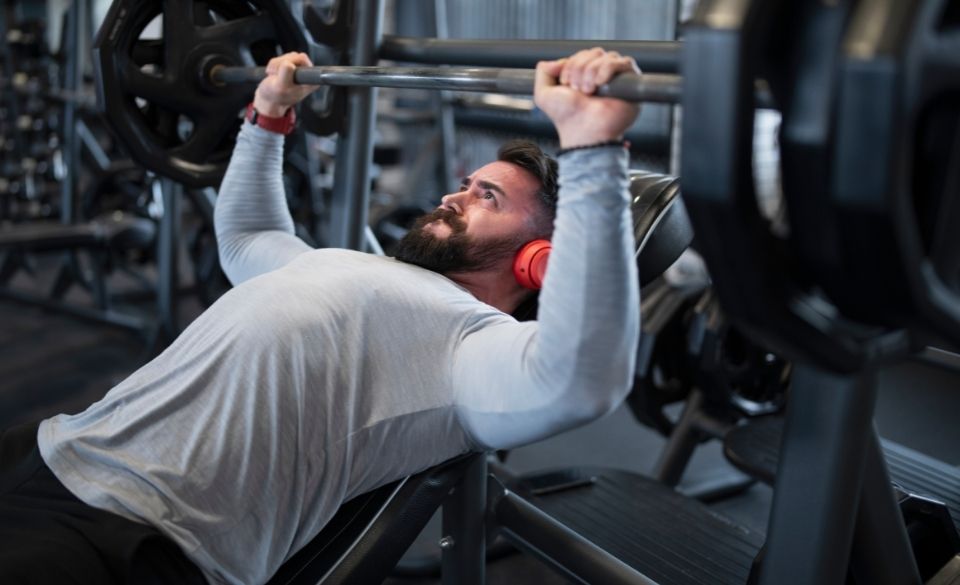
Understanding Elbow Flare – UPDATED 2022 – A Complete Guide
Page Contents
Human error means that making mistakes is normal. No matter what you do, you’re going to do it wrong – this is especially true with working out. It’s normal and something you should expect and then accept.
If you’re a beginner, it’s easy to fall into the trap of making a single mistake, and then turning it into a habit. This is often what happens with the elbow flare during lifts. Understanding elbow flare is the first step to correcting it…and you might find out that you’re doing it without even realizing it.
In this guide, we’ll discuss what elbow flare is, how to deal with it, and why it happens.
Understanding Elbow Flares – A Complete Guide
When you do a lift, each part of your arm needs to be engaged. Your upper and your lower arm should both be feeling the benefits of a lift, but they should also be in the correct position and posture to keep you safe.
An elbow flare is a key mistake in positioning during a lift. It’s less obvious than it sounds to spot though. You sometimes can’t feel it when your elbow flares.
What exactly is it then? In general, you might have heard the phrase elbow tuck and flare. This refers to the way your elbows are positioned during a lift. Tuck and flare can be a difficult concept to get your head around.
An elbow tuck is considered to be the correct way to position your elbows. Elbow flare, on the other hand, is incorrect.
When your elbows are tucked, it’s referring to how ‘in’ your elbows are in relation to your arms and the rest of your body. If your elbows are tucked, then this means they’re closer to your arms than the bar. The ideal amount of elbow tuck is for your elbows to be just in front of the bar.
Regarding flare, it’s a similar concept. Instead, this means how far out your elbows are horizontally. Ideally, you don’t want your elbows to be flared at all, and instead to be tucked.
The tricky thing is that elbow flare is deceiving in that it actually might feel more comfortable and natural than elbow tuck. But elbow flare has a lot of risks. These include increased risk of shoulder and arm injury and ineffective lifting.
It’s not just lifting that can put you at risk of elbow flare either. It can also happen when you do push-ups and some types of machine exercises.
Dealing with Flared Out Elbows
Once you identify the problem with your elbow firm during lifts, the next step is to fix it. This is easier said than done. As mentioned, it’s possible that your muscle memory of how to do a lift already has elbow flares ingrained into it.
Dealing with elbow flares takes conscious effort and awareness. The first few times you try to correct your form, you might not see any progress at all.
One of the best tips is to be proactive. Make sure to check your elbow posture every so often when doing a lift. As soon as you lift the barbell, make a point to tuck in your elbows. This will help associate lifting a barbell with tucked elbows, and therefore good form.
Another great tip is to change the way you think of holding the bar. When you lift, you should try to focus on bending the bar, and not breaking the bar. What this means is that you need to change how you control the pressure of your grip on the bar.

Getting Started with Elbow Flare Push-Ups
Remember how we mentioned that during push-ups you’re also at risk of elbow flare? Again, just like with lifts, you might find this position more comfortable and natural. This is because it evenly spreads out the weight and pressure.
Elbow flare during push-ups is just as bad as during lifts. Getting started with curing it is a similar process to that of curing it during lifts. For push-ups, it might even be easier.
Push-ups are as much about form and posture as they are about upper arm strength. To try and get used to tucking your elbows, you should try a standard plank. With the plank, you almost need your elbows to be tucked to support your body effectively,
The optimal elbow position during a push-up is between 30 degrees and 50 degrees. This is a comfortable tuck that will make your push-ups more effective and dramatically reduce your risk of injury from them.
Why Do Elbows Flare Out?
If it’s bad, then why do elbows flare out in the first place? The cause of all of these risks associated with elbow flare is thanks to a small part of your supraspinatus muscle tendon called the bursa.
This is a small sac that protects your supraspinatus muscle tendon from rubbing against the bone. When a muscle rubs against the bone, it can cause tendinitis.
However, when your elbows flare out, the bursa is no longer protecting the supraspinatus tendon from the bone of your elbow. This means it’s free to rub against the bone and cause injury.
In day-to-day life, this isn’t an issue. But when the tendon is unprotected during strenuous exercise such as lifting, it can quickly cause the tendon to wear down and become weaker.
The reason for elbow flare is your body trying to help you. This motion is a natural result of your body attempting to engage your shoulders and tighten your chest. It’s possible to do this without causing flared elbows, but since this is the easiest way it’s what your body defaults to.
Elbow Flare – Closing Thoughts
Elbow flare is a common problem and is one of the most common push-up mistakes. That’s why you shouldn’t feel bad if you find yourself struggling with it. With sustained effort and training your mind and muscles, you can cement a proper posture when doing barbell lifts, push-ups, and other upper body exercises.


